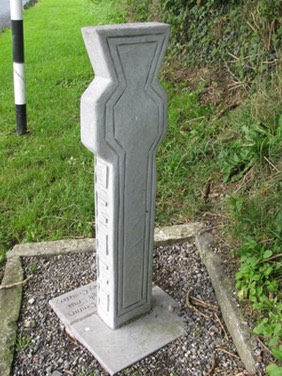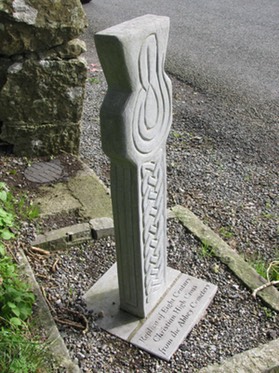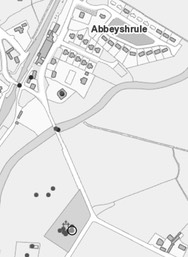
Only one cross has been identified in County Longford. It is at Abbeyshrule. The location of County Leitrim is indicated by the red star on the map to the right.
Historical Background on County Longford
What is now County Longford was, between the 5th and 12th centuries, a part of the Kingdom of Meath. Midhe or the “middle kingdom” was itself composed of Mide and the plain of Brega, as illustrated in the map below. The area where County Longford now is, was known as Tethbae and was ruled by various tuath, including the Cairpre Gabra, of the Southern Ui Neill. By the 7th century, Tethbae was divided politically between the north, centered around Granard, and the south, centered around Ardagh. Both centers were located in what is now County Longford. It was in the 7th century that the Cairpre Gabra were first mentioned in the Irish Annals. (The map was found at: https://sites.rootsweb.com/~irlkik/ihm/mide.htm)
In the 11th century the Cairpre Gabra were conquered by various Conmhaicne tribes. The Conmhaicen moved into the area from farther west, in eastern Connachta. The area that is now County Longford became known as Annaly and the chief clan was the O’Farrells.
Ecclesiastical History of County Longford
In the early Christian period the Two Tethbae were divided both politically, as noted above, and ecclesiastically. The churches aligned with Granard and North Tethbae were loyal to St. Patrick and Armagh. Those in South Tethbae, founded by St. Mel, became loyal to Kildare and St. Brigit.
There were a number of monastic houses located in what is now County Longford before the end of the first millennium. The following list includes sites named in a List of Monastic Houses in County Longford. (https://en.wikipedia.org/wiki/List_of_monastic_houses_in_County_Longford) In this list I include Abbeyshrule Abbey because while latter, it has the only High Cross in County Longford.
Abbeyshrule Abbey Cistercian Monks, founded 1200, an earlier monastery was probably located here
Ardagh Monastery early site, founded 5th century by Patrick or Mel
Clonbroney Abbey early site, nuns, possibly founded 5th century by St. Patrick
Cloondara Monastery early site, 6th century, patron St. Ernan
Druim-cheo Nunnery possible early site
Forgney Monastery early site, founded 5th century by St. Patrick
Granard Monastery early site, founded 5th century by St. Patrick
Inchcleraun Priory early site, founded 6th century by St. Diarmuid
Inchmore Priory early site, founded 6th century by St. Colmcille
Kilglass Monastery possible early site, nuns, founded by St. Eiche, sister of St. Mel and niece of St. Patrick (?)
Kilmodain Monastery early site
Raithin Monastery early site, founded 5th century by St. Patrick
Saints Island Priory questionable early site, founded 6th century by St. Ciaran
Abbeyshrule Cross
The Site
The name Abbeyshrule derives from a combination of “Abbey”, referring to the Cistercian Abbey founded there about 1150 and the old Gaelis “sruth” meaning stream or river. So the name refers to the Abbey on the River Inney. (askaboutireland)
The history of the site is uncertain. A Rev. MacGivney, writing in 1908 suggested that there was a monastery there in the late 9th century that was destroyed by the Danes. The cross at the site may date to the late 8th or early 9th century and be a product of this monastery.
What is certain is that in the mid to late 12th century a Cistercian Abbey was established, perhaps as early as 1150, with the support of O’Farrell, prince of Annaly. This Abbey was the fifth Cistercian abbey founded under the leadership of Mellifont. It was dedicated to the Virgin Mary. The ruins are from about 1200. About 1228 the affiliation of the Abbey switched from Mellifont to Bective Abbey. (moxhamireland)
The Cross
Crawford described the cross in 1924. It stands to a height of 3 feet. It is ringless and the arms are missing.
East Face: There is an incised cross on this face that covers the entire face and appears to have a ring. See the photo below right.
West Face: On the shaft is a plait of five strands. On the head is a curious design formed by three concentric lines that has the appearance of a horseshoe. (Crawford, p. 171) Harbison describes the west head as having “a round boss in the centre, enclosed by two roll mouldings which expand outwards on the uppermost limb.” (Harbison, 1992, p. 9) Hence the horseshoe description by Crawford. See the photo below left.
Sides: One side bears vertical ribs (photo left), the other a meander pattern (photo right).



Getting There: See the Road Atlas page 34, E1. The replica is located just south of Abbeyschrule at the Abbey. It is located just beside the road. The map is cropped from the Historic Envirnoment Viewer.
Resources Consulted
Crawford, Henry S., “Cross at Abbeyshrule, County Longford”, The Journal of the Royal Society of Antiquaries of Ireland, Sixth Series, Vol. 14, No. 2 (Dec. 31, 1924), p. 171
Harbison, Peter; "The High Crosses of Ireland: An Iconographical and Photographic Survey", Dr. Rudolf Habelt GMBH, Bonn, 1992. Volume 1: Text, Volume 2: Photographic Survey; Volume 3: Illustrations of Comparative Iconography.
List of Monastic Houses in County Longford. (https://en.wikipedia.org/wiki/List_of_monastic_houses_in_County_Longford)
https://moxhamireland.wordpress.com/2015/02/11/abbeyshrule/
http://www.askaboutireland.ie/learning-zone/primary-students/looking-at-places/longford/aspects-of-longford/abbeyshrule/